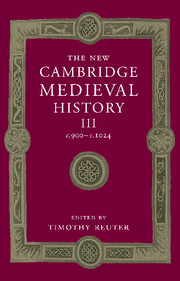Book contents
- Frontmatter
- 1 Introduction: reading the tenth century
- PART I GENERAL THEMES
- PART II POST-CAROLINGIAN EUROPE
- PART III NON-CAROLINGIAN EUROPE
- 19 European Russia, c. 500–c. 1050
- 20 Bohemia and Poland: two examples of successful western Slavonic state-formation
- 21 Hungary
- 22 Byzantium in equilibrium, 886–944
- 23 Bulgaria: the other Balkan ‘empire’
- 24 Byzantium expanding, 944–1025
- 25 Byzantium and the West
- 26 Southern Italy in the tenth century
- 27 Sicily and al-Andalus under Muslim rule
- 28 The Spanish kingdoms
- Appendix genealogical tables
- List of primary sources
- Bibliography of secondary works arranged by chapter
- Index
- Frontispiece
- Plate section
- Map 2: Archbishoprics and bishoprics in the early eleventh century
- Map 4: Germany
- Map 13: Byzantium in 1025
- References
22 - Byzantium in equilibrium, 886–944
from PART III - NON-CAROLINGIAN EUROPE
Published online by Cambridge University Press: 28 March 2008
- Frontmatter
- 1 Introduction: reading the tenth century
- PART I GENERAL THEMES
- PART II POST-CAROLINGIAN EUROPE
- PART III NON-CAROLINGIAN EUROPE
- 19 European Russia, c. 500–c. 1050
- 20 Bohemia and Poland: two examples of successful western Slavonic state-formation
- 21 Hungary
- 22 Byzantium in equilibrium, 886–944
- 23 Bulgaria: the other Balkan ‘empire’
- 24 Byzantium expanding, 944–1025
- 25 Byzantium and the West
- 26 Southern Italy in the tenth century
- 27 Sicily and al-Andalus under Muslim rule
- 28 The Spanish kingdoms
- Appendix genealogical tables
- List of primary sources
- Bibliography of secondary works arranged by chapter
- Index
- Frontispiece
- Plate section
- Map 2: Archbishoprics and bishoprics in the early eleventh century
- Map 4: Germany
- Map 13: Byzantium in 1025
- References
Summary
in the late ninth century the Byzantine emperor’s dominions were straggling and vulnerable. The survival of the state was not in question but the government of Leo VI (886–912) faced harassment and humiliating reverses on several fronts, while fears of rebellions were all too lurid for a royal family which owed everything to a bloody palace coup barely a generation earlier.
It is against this background that one should view the various manuals of governance and law-collections dating from Leo’s reign. They evince his enthusiasm for order, godliness and good learning. Besides commissioning, compiling or interpolating these works he wrote numerous sermons. He aspired to be acknowledged as the fount of wisdom and pious enlightenment, judging by the description of his bath-house near the palace complex. Leo’s sobriquet, ‘the Wise’, implied in the bath-house imagery, acclaimed by contemporary courtiers and derided by Symeon of Bulgaria, was not wholly undeserved. Like his father Basil I, he wished his rule to be associated with illustrious figures of the Christian empire’s acknowledged heyday, notably Constantine and Justinian. At the same time he propagated the idea of renewal in, for example, his highly euphemistic version of Basil’s accession: the former state of affairs had been removed together with Basil’s senior co-emperor, Michael III, ‘for the purpose of fresh and well-ordered change’.
Keywords
- Type
- Chapter
- Information
- The New Cambridge Medieval History , pp. 553 - 566Publisher: Cambridge University PressPrint publication year: 2000



